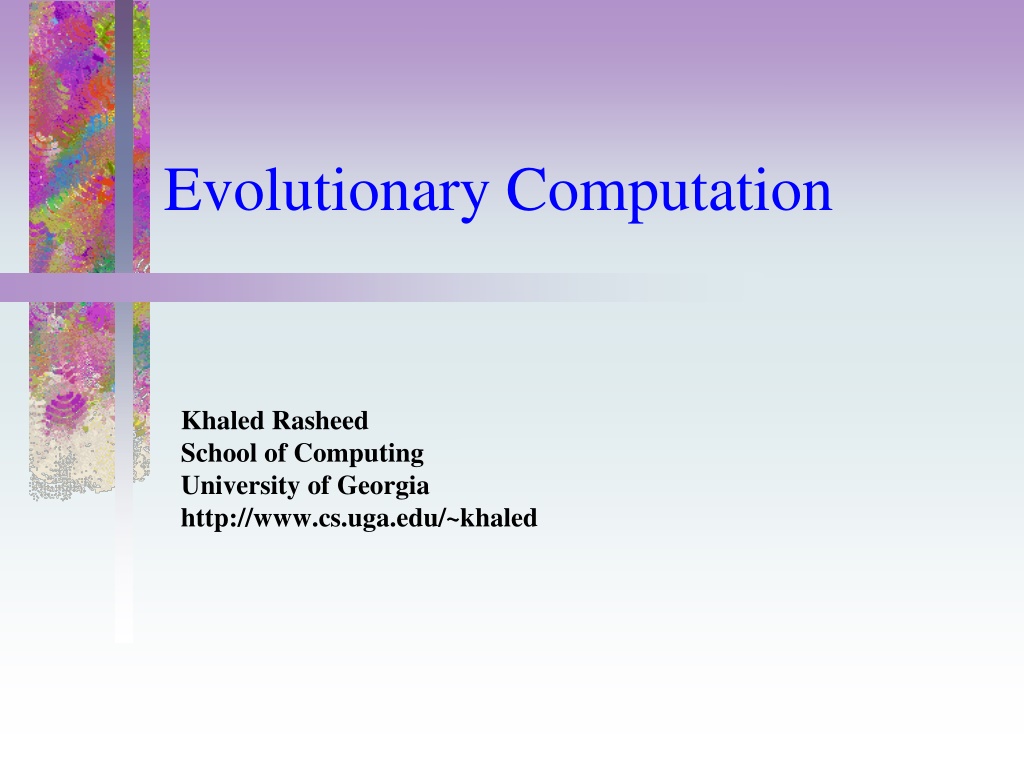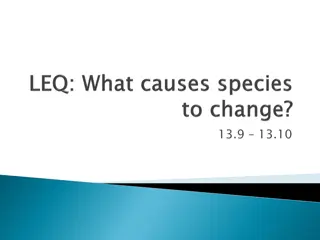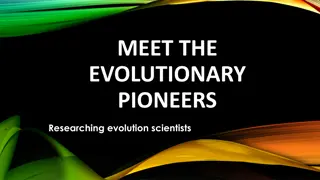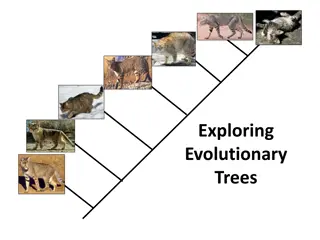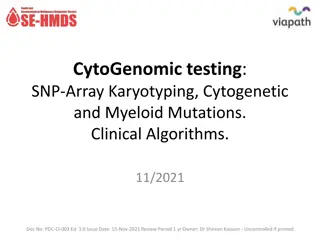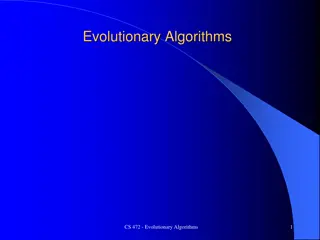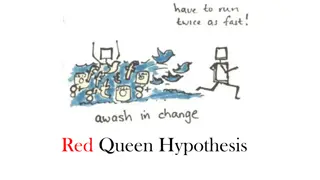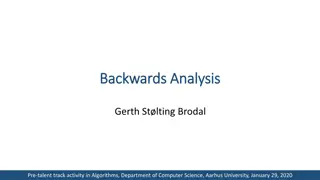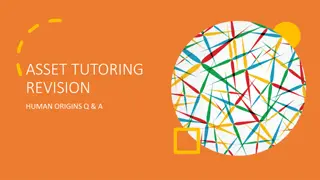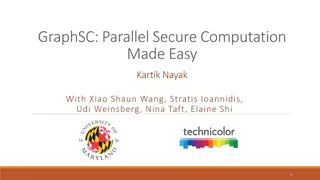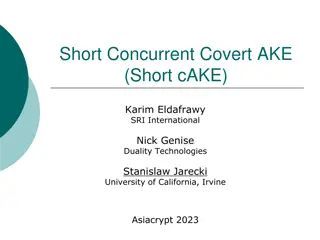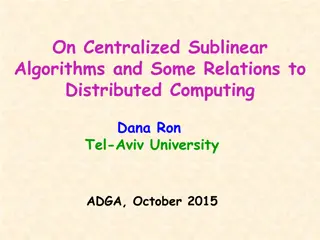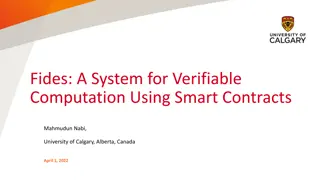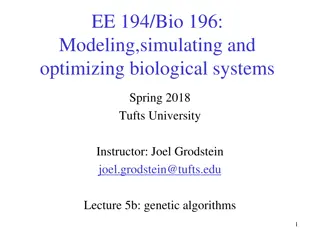Evolutionary Computation and Genetic Algorithms Overview
Explore the world of evolutionary computation and genetic algorithms through a presentation outlining the concepts of genetic algorithms, parallel genetic algorithms, genetic programming, evolution strategies, classifier systems, and evolution programming. Delve into scenarios in the forest where giraffe and tree species evolve over a million years, discussing the potential changes in height and fitness. Understand how genetic algorithms work to maintain populations of potential solutions, generate new solutions through selection and modification, and optimize objectives through fitness functions. Examples of numerical optimization and binary representation showcase practical applications of these concepts in problem-solving.
- Evolutionary Computation
- Genetic Algorithms
- Optimization
- Evolution Strategies
- Computational Intelligence
Uploaded on Sep 21, 2024 | 0 Views
Download Presentation

Please find below an Image/Link to download the presentation.
The content on the website is provided AS IS for your information and personal use only. It may not be sold, licensed, or shared on other websites without obtaining consent from the author. Download presentation by click this link. If you encounter any issues during the download, it is possible that the publisher has removed the file from their server.
E N D
Presentation Transcript
Evolutionary Computation Khaled Rasheed School of Computing University of Georgia http://www.cs.uga.edu/~khaled
Presentation outline Genetic algorithms Parallel genetic algorithms Genetic programming Evolution strategies Classifier systems Evolution programming Related topics Conclusion
In the forest Initially equal proportions of Giraffe and tree species
One million years later Average Giraffe height will probably Increase same Decrease
One million years later Average tree height will probably Increase same Decrease
One million years later Maximum Giraffe height will probably Increase same Decrease
One million years later Maximum tree height will probably Increase same Decrease
In the forest Fitness = Height Survival of the fittest
Genetic Algorithms Maintain a population of potential solutions New solutions are generated by selecting, combining and modifying existing solutions Crossover Mutation Objective function = Fitness function Better solutions favored for parenthood Worse solutions favored for replacement
Example: numerical optimization Maximize 2X^2-y+5 where X:[0,3],Y:[0,3]
Example with binary representation Maximize 2X^2-y+5 where X:[0,3],Y:[0,3]
Elements of a generational genetic algorithm Representation Fitness function Initialization strategy Selection strategy Crossover operators Mutation operators
Elements of a steady state genetic algorithm Representation Fitness function Initialization strategy Selection strategy Crossover operators Mutation operators Replacement strategy
Selection strategies Proportional selection (roulette wheel) Selection probability of individual = individual s fitness/sum of fitness Rank based selection Example: decreasing arithmetic/geometric series Better when fitness range is very large or small Tournament selection Virtual tournament between randomly selected individuals using fitness
Crossover Operators Point crossover (classical) Parent1=x1,x2,x3,x4,x5,x6 Parent2=y1,y2,y3,y4,y5,y6 Child =x1,x2,x3,x4,y5,y6 Uniform crossover Parent1=x1,x2,x3,x4,x5,x6 Parent2=y1,y2,y3,y4,y5,y6 Child =x1,x2,y3,x4,y5,y6 Arithmetic crossover Parent1=x1,x2,x3 Parent2=y1,y2,y3 Child =(x1+y1)/2,(x2+y2)/2,(x3+y3)/2
Mutation Operators change one or more components Let Child=x1,x2,P,x3,x4... Gaussian mutation: P P p p: (small) random normal value Uniform mutation: P P new p new : random uniform value boundary mutation: P Pmin OR Pmax Binary mutation=bit flip
Advantages of Genetic-Algorithm based optimization Finds global optima Can handle discrete, continuous and mixed variable spaces Easy to use (short programs) Robust (less sensitive to noise, ill conditions)
Disadvantages of Genetic- Algorithm based optimization Relatively slower than other methods (not suitable for easy problems) Theory lags behind applications
Hybrid parallel GA Coarse-grained GA at high level Fine-grained GA at low level
Hybrid parallel GA Coarse-grained GA at high level Global parallel GA at low level
Hybrid parallel GA Coarse-grained GA at high level Coarse-grained GA at low level
Genetic Programming (GP) Introduced (officially) by John Koza in his book (genetic programming, 1992) Early attempts date back to the 50s (evolving populations of binary object codes) Idea is to evolve computer programs Declarative programming languages usually used (Lisp) Programs are represented as trees
GP individuals A population of trees representing programs The programs are composed of elements from the FUNCTION SET and the TERMINAL SET These sets are usually fixed sets of symbols The function set forms "non-leaf" nodes. (e.g. +,-,*,sin,cos) The terminal set forms leaf nodes. (e.g. x,3.7, random())
GP operation Fitness is usually based on I/O traces Crossover is implemented by randomly swapping subtrees between individuals GP usually does not extensively rely on mutation (random nodes or subtrees) GPs are usually generational (sometimes with a generation gap) GP usually uses huge populations (1M individuals)
Advantages of GP over GAs More flexible representation Greater application spectrum If tractable, evolving a way to make things is more useful than evolving the things . Example: evolving a learning rule for neural networks vs. evolving the weights of a particular NN.
Disadvantages of Genetic Programming Extremely slow Very poor handling of numbers Very large populations needed
GP variants Genetic programming with linear genomes (Wolfgang Banzaf) Kind of going back to the evolution of binary program codes Hybrids of GP and other methods that better handle numbers: Least squares methods Gradient based optimizers Genetic algorithms, other evolutionary computation methods Evolving things other than programs Example: electric circuits represented as trees (Koza, AI in design 1996)
Evolution Strategies (ES) Were invented to solve numerical optimization problems Originated in Europe in the 1960s Initially: two-member or (1+1) ES: one PARENT generates one OFFSPRING per GENERATION by applying normally distributed (Gaussian) mutations until offspring is better and replaces parent This simple structure allowed theoretical results to be obtained (speed of convergence, mutation size) Later: enhanced to a ( +1) strategy which incorporated crossover
Modern evolution strategies Schwefel introduced the multi-membered ESs now denoted by ( + ) and ( , ) ( , ) ES: The parent generation is disjoint from the child generation ( + ) ES: Some of the parents may be selected to "propagate" to the child generation
ES individuals Real valued vectors consisting of two parts: Object variable: just like real-valued GA individual Strategy variable: a set of standard deviations for the Gaussian mutation This structure allows for "Self- adaptation of the mutation size Excellent feature for dynamically changing fitness landscape
Machine learning and evolutionary computation In machine learning we seek a good hypothesis The hypothesis may be a rule, a neural network, a program ... etc. GAs and other EC methods can evolve rules, NNs, programs ...etc. Classifier systems (CFS) are the most explicit GA based machine learning tool.
Elements of a classifier system Rule and message system if <condition> then <action> Apportionment of credit system Based on a set of training examples Credit (fitness) given to rules that match the example Example: Bucket brigade (auctions for examples, winner takes all, existence taxes) Genetic algorithm evolves a population of rules or a population of entire rule systems
The Michigan approach: population of rules Evolves a population of rules, the final population is used as the rule and message system Diversity maintenance among rules is hard If done well converges faster Need to specify how to use the rules to classify what if multiple rules match example? exact matching only or inexact matching allowed?
The Pittsburgh approach Each individual is a complete set of rules or complete solution Avoids the hard credit assignment problem Slow because of complexity of space
Evolution programming (EP) Classical EP evolves finite state machines (or similar structures) Relies on mutation (no crossover) Fitness based on training sequence(s) Good for sequence problems (DNA) and prediction in time series
EP mutation operators Add a state (with random transitions) Delete a state (reassign state transitions) Change an output symbol Change a state transition Change the start state
Modern EP No specific representation Similar to Evolution Strategies Most work in continuous optimization Self adaptation common No crossover ever used!
Other evolutionary computation "ways" Representations based on description of transformations instead of enumerating the parameters of the individual, describe how to change another (nominal) individual to be it. Good for dimension reduction, at the expense of optimality Surrogate assisted evolution methods Good when objective function is very expensive fit an approximation to the objective function and uses it to speed up the evolution Differential Evolution
Related Topics Artificial life An individual s fitness depends on genes + lifetime experience An individual can pass the experience to offspring Co-evolution Several populations of different types of individuals co-evolve Interaction between populations changes fitness measures
Other Nature Inspired Heuristics Ant Colony Optimization Inspired by the social behavior of ants Useful in problems that need to find paths to goals Particle Swarm optimization Inspired by social behavior of bird flocking or fish schooling The potential solutions, called particles, fly through the problem space by following the current optimum particles
The bigger picture All evolutionary computation models are getting closer to each other The choice of method is important for success EC provides a very flexible architecture easy to combine with other paradigms easy to inject domain knowledge
EC journals Evolutionary Computation IEEE transactions on evolutionary computation Genetic programming and evolvable machines other: AIEDAM, AIENG ...
